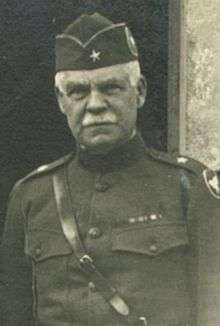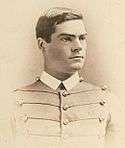George W. McIver
George W. McIver (February 22, 1858 – May 9, 1947) was a United States Army Brigadier General who served as acting Chief of the Militia Bureau and commanded the 161st Infantry Brigade in World War I.
George W. McIver | |
|---|---|
 McIver as commander of 161st Infantry Brigade, World War I | |
| Born | February 22, 1858 Carthage, North Carolina |
| Died | May 9, 1947 (aged 89) Washington, D.C. |
| Place of burial | |
| Allegiance | |
| Service/ | |
| Years of service | 1882–1922 |
| Rank | |
| Commands held | U.S. Military Prison, Alcatraz Island School of Musketry Militia Bureau 161st Infantry Brigade 81st (Wildcat) Division Demobilization Group, Camp Pike, Arkansas Recruit Depot, Fort Slocum, New York |
| Battles/wars | American Indian Wars Spanish–American War World War I |
Early life

George Willcox (sometimes spelled Wilcox) McIver was born in Carthage, North Carolina, on February 22, 1858.[1] He attended the University of North Carolina at Chapel Hill from 1869 to 1870 while his father was a professor there, graduated from the United States Military Academy in 1882 and received his commission as a second lieutenant of infantry.[2]
Initially assigned to the 17th Infantry Regiment, McIver served throughout the western United States during the American Indian Wars, including postings to Forts Pembina, Fred Steele, Laramie, Logan, and Bridger. In 1885 he was part of a force sent to Rock Springs, Wyoming, to intervene during unrest between Chinese and white miners (the Rock Springs Massacre). McIver participated in the Sioux Campaign of 1890–1891. He served as a tactical officer at West Point from 1891 to 1893, and was assigned to Camp Pilot Butte (also known as Camp Rock Springs), Wyoming from 1893 to 1894, after which he was posted as the regular Army officer advising the California National Guard.[3][4]
Spanish–American War
In 1898, he returned to the 7th Infantry for service in Cuba during the Spanish–American War, and took part in the battles of El Caney and San Juan Hill.[5]
Post Spanish–American War
From 1898 to 1900, McIver was stationed at Fort Brady, Michigan, and at Leech Lake Indian Agency in Walker, Minnesota. From 1900 to 1901, he was stationed at Forts Davis and St. Michael, Alaska. McIver was on recruiting duty in Portland, Oregon, from 1901 to 1903.[6]
He was assigned to the Philippines from 1903 until 1905.[7]
From 1905 to 1907 McIver was Commandant of the U.S. Military prison on Alcatraz Island in San Francisco Bay. He supervised the construction of buildings erected in Golden Gate Park to provide temporary housing for people whose homes were destroyed in the 1906 San Francisco earthquake.[8]
In 1907, he became the Commandant of the School of Musketry in Monterey, California, and was responsible for the publication of the Army Small Arms Firing Manual.[9] He served again in the Philippines from 1912 to 1914. In 1915, McIver was assigned as executive officer of the National Guard Bureau. From September to October, 1916, he served as acting Chief of the Militia Bureau during the interregnum between the death of Albert Mills and the arrival of Mills' replacement, William A. Mann.[10]
World War I
In 1917, McIver was promoted to brigadier general and took command of the 161st Brigade of the 81st (Wildcat) Division.[11] The 81st Division was made up largely of recruits from North and South Carolina, and trained in South Carolina at Camp Sevier (near Greenville) and Camp Jackson (near Wildcat Creek, which gave the division its nickname).[12]
McIver led the brigade during combat on the Western Front in France, including participation in the Meuse-Argonne Offensive. While serving as brigade commander, he also served on three occasions as interim commander of the 81st Division between December, 1917 and July, 1918.[13] McIver had a mixed record on the issue of race, but was regarded as more progressive than his peers. Though he worked to have Puerto Rican soldiers transferred from the 161st Brigade, he successfully integrated Lumbees and other Native Americans from North Carolina. In addition, based on his Indian Wars experience, he expressed the view that African-Americans made good soldiers and should be allowed to serve, though he also believed that they could do so successfully only if led by white officers.[14]
At the end of World War I, McIver was recommended for the Distinguished Service Medal, but it does not appear to have been approved.[15]
Post World War I
Following the war, McIver returned to his permanent rank of colonel.[16] From 1919 until his retirement in 1922, he commanded first the Demobilization Group at Fort Pike, near Little Rock, Arkansas (now Camp Joseph T. Robinson) and then the recruit depot at Fort Slocum, New York.[17]
Death and burial
In retirement, McIver resided in Washington, D.C. In 1930, he was promoted to Brigadier General on the retired list.[18] He died in Washington, D.C. on May 9, 1947. He is buried in Arlington National Cemetery, Section 6, Site 5680A.[19]
Family
In 1893, McIver married Helen Howard Smedberg (1869–1953).[20] They were the parents of two daughters and three sons:
- Frances (1896–1968), the wife of Navy officer Paul Mefford Runyon[21][22][23]
- George Jr. (1897–1962), a graduate of the United States Naval Academy, business executive, Navy officer, and Army officer during World War I[24][25]
- Renwick (1901–1987), also a graduate of the United States Naval Academy and Navy officer[26][27]
- Alexander (1907–1956), a graduate of the Virginia Military Institute and Army officer[28][29]
- Cora (1912–1971), the wife of government policy specialist and conservationist Harold H. Leich[30]
Helen McIver was the daughter of William R. Smedberg (1839–1911), a veteran of the Union Army who remained in the military after the American Civil war and retired as a lieutenant colonel.[31] Her brother William R. Smedberg Jr. (1871–1942) was a career Army officer who attained the rank of brigadier general during World War I.[32] Her nephew William R. Smedberg III (1902–1994), was a Navy vice admiral who served as Superintendent of the Naval Academy. Her grandnephew William R. Smedberg IV (1929–2008) was also a career Navy officer, and he attained the rank of rear admiral.
Legacy
The George Willcox McIver Papers are part of the East Carolina University's Joyner Library collections.[33]
McIver's autobiography, A Life of Duty: The Autobiography of George Willcox McIver, 1858–1948, was edited by Jonathan Dembo and published in 2006.[34]
References
- East Carolina University, George Willcox McIver Papers, Biographical sketch, George Willcox McIver, 2011
- Burke's Peerage, Burke's Distinguished Families of America, 1948, page 2809
- George Washington Cullum, Biographical Register of the Officers and Graduates of the U.S Military Academy, Volume 4, 1901, pages 358–359
- California Adjutant General, Annual Report, 1894, page 160
- University of North Carolina, Carolina Alumni Review, "Career of General McIver", February, 1918, page 126
- George W. Cullum, Biographical Register of the Officers and Graduates of the U.S. Military Academy, 1910, page 335
- George Washington Cullum, Edward Singleton Holden, Biographical Register of the Officers and Graduates of the U.S. Military Academy, 1920, pages 338–339
- George W. Cullum, Biographical Register of the Officers and Graduates of the U.S. Military Academy, 1910, page 335
- United States War Department, Annual Reports, Volume 3, 1910, page 139
- United States War Department, Report of the Chief of the Militia Bureau, Volume 1, 1916, page 947
- Floyd Gibbons, And They Thought We Wouldn't Fight, 1918, page 255
- North Carolina State Archives, The Old North State and 'Kaiser Bill': North Carolinians in World War I; 81st Division "Wildcats" Archived 2013-05-02 at the Wayback Machine, accessed May 3, 2013
- Center of Military History, United States Army, Order of Battle of the United States Land Forces in the World War: American Expeditionary Forces, 1988, page 338
- Stanley W. Black, Amazon.com, Review, A Life of Duty, April 14, 2010
- Stanley W. Black, Review, A Life of Duty
- Davis, Jr., Henry Blaine (1998). Generals in Khaki. Pentland Press, Inc. p. 260. ISBN 1571970886. OCLC 40298151
- George Washington Cullum, Edward Singleton Holden, Biographical Register of the Officers and Graduates of the U.S. Military Academy, 1920, pages 338-339
- University of North Carolina, Carolina Alumni Review, 1873, McIver, October, 1930, page 18
- Arlington National Cemetery, Burial record for George W. McIver, accessed May 3, 2013
- "Obituary, George W. McIver, 1882". West Point Alumni memorials. West Point, NY: West Point Association of Graduates. 1948.
- "Engagements". Gossip: The International Journal of Society. New York, NY: Sherwin Publishing Corporation. October 7, 1921. p. 16.
- "Miss M'Iver Weds Paul M. Runyon; Colonel's Daughter a Bride in the Chapel of St. Sebastian, Fort Slocum". New York Times. New York, NY. December 4, 1921.
- "Death Notice, Frances Runyon". Washington Post and Times-Herald. Washington, DC. December 20, 1968.
- "Hymeneal Record of the Week: McIver-Maule". American Lumberman. Chicago, IL: American Lumberman Publishing Co. July 3, 1920. p. 82.
- "Clara McFadden Bride of George W. McIver, Jr". Delaware County Times. Chester, PA. April 28, 1931. p. 3.
- United States Naval Academy (1919). Annual Register of the United States Naval Academy. 75. Washington, DC: US Government Printing Office. p. 102.
- "Anne S. McIver, '59 Debutante, Becomes Bride". New York Times. New York, NY. February 23, 1964.
- Yearbook of the Virginia Military Institute. Lexington, VA: Virginia Military Institute. 1928. p. 507.
- "Death Notice, Helen Howard McIver". New York Times. New York, NY. October 14, 1953.
- "Harold H. Leich Dies". Washington Post. Washington, DC. September 11, 1981.
- San Francisco: Its Builders, Past and Present. 2. San Francisco, CA: S. J. Clarke Publishing Co. 1913. p. 159.
- San Francisco: Its Builders, Past and Present
- East Carolina University, George Willcox McIver Papers, Collection description, George Willcox McIver Papers, 2011
- George Willcox McIver, A Life of Duty: The Autobiography of George Willcox McIver, 1858–1948, 2006, title page
| Military offices | ||
|---|---|---|
| Preceded by Albert L. Mills |
Chief of the National Guard Bureau 1916 |
Succeeded by William Abram Mann |